
The Pros and Cons of a New Ferry Line at Berkeley Marina, Part 1
As ferry service in the Bay Area continues to expand, Berkeley Marina is considering a new ferry terminal located on the now-shuttered University Avenue Pier to service a route to San Francisco. The potential project, which will soon go to a yearlong public-engagement process, is part of Berkeley Marina’s wider, long-term plan to create a financially self-sustaining, publicly owned marina. As we’ve reported, much of the Marina’s infrastructure has “aged out,” and the price tag to replace docks, roads and the 83-year-old pier — which closed in 2015 due to structural safety issues — far exceeds the self-sustaining financial model, or Marina Fund, leaving the City to seek out money where it can.
“The Marina Fund is designed to support all aspects of the waterfront; the financial feasibility of this fund supporting these elements with its current revenues is unrealistic,” a recent City of Berkeley memo read. Grants and loans have helped finance a few new infrastructure projects at the Marina, but there’s still plenty of work to be done. The question of how to renovate the once-popular pier, which has a price tag of between $17 million and $55 million, remains open.
The City of Berkeley has been working on a study with the Water Emergency Transportation Authority, or WETA — the Bay Area’s largest public-commuter ferry service — to determine the feasibility of a joint project to rebuild the pier and open a new line. While the specifics of who would pay for what will be worked out in the coming year, the City of Berkeley is looking for partners to inject cash into building a new pier and breakwaters and for dredging, as well as for renovations to existing parking lots, walkways and restrooms.
Opponents of the ferry point out that while the partnership with WETA might help finance a new pier, a Berkeley ferry line would not provide regular taxable revenue to the Marina Fund in the way that restaurants, hotels and other businesses do. A city official told us that the city believes the ferry project “could be a catalyst for revenue associated with the Marina Fund, as the percentage rent from existing or new restaurants and hotels in the Marina could increase from additional foot traffic. Over the next year, the city will study the financial opportunities of the ferry/pier project in both planning studies.”

The new Berkeley terminal was first proposed in 2009, but was ultimately rejected. At the time, the project was criticized because the city was expected to be saddled with at least part of the operational costs of running the line. (It’s not uncommon for cities to partner with WETA as a means of investing in their public transit.) The project was also unpopular with recreational advocates, who said that the design of the terminal would cut into waters used by windsurfers, kayakers, swimmers, and the occasional dinghy. Recent design proposals for a pier terminal are relatively unchanged.
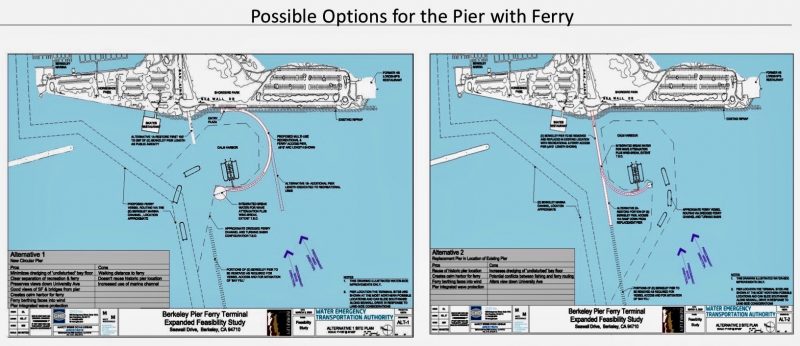
The financial landscape has changed since 2009. In 2018, Bay Area voters approved Regional Measure 3, and WETA “is expected to receive up to $300 million for one-time capital construction projects, and up to $35 million per year to operate an expanded region-wide ferry system,” the City of Berkeley wrote, adding that pre-COVID Bay Area ferry ridership was up 94% since 2012. WETA plans to widely expand its services, with seven locations around the Bay, and a “robust 16-terminal regional network” under consideration. (The money from Regional Measure 3 is currently tied up in a lawsuit, but the funds should eventually become available.)
Given the potential for an expanded fleet, there’s a sense of urgency to move away from diesel ferries to low- or zero-emission vessels. While there are numerous prototypes around the world, there has yet to be a “breakthrough boat” to hit Bay Area waters, which would presumably open the door for a green fleet. New boats on the Bay are as low-emission as they’ve ever been, but ferries still have a large carbon footprint, and are among the most inefficient modes of transportation in terms of fuel used per passenger-mile (though single-occupancy cars are by far the most inefficient).
The pandemic has decimated public-transportation usage. According to a WETA spokesperson, ridership is down about 90%. It’s not clear what lasting impacts the pandemic will have on overall ridership — will part of the workforce permanently shift to remote employment, or will there be pent-up demand to get back to the office? Regardless, it’s fair to say that there’s an abundance of public interest, political will and hard cash ready to be invested into Bay Area ferries.
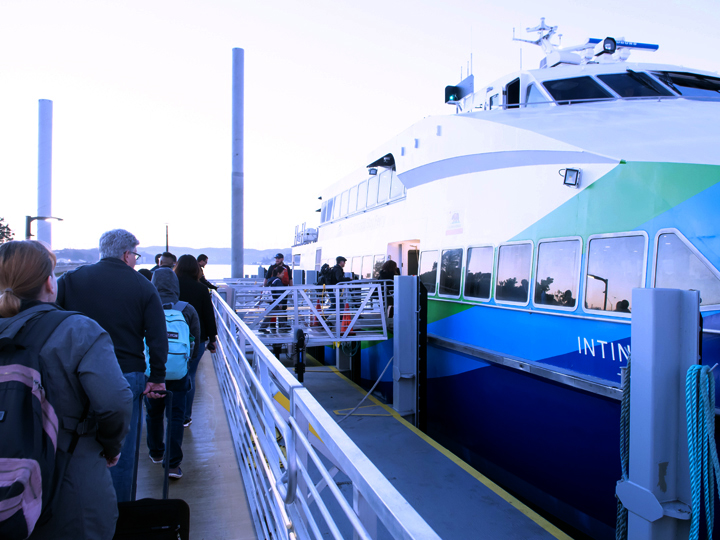
The Bay Area Ferry Landscape
WETA is one of two Bay Area public ferry lines. There are numerous “tourist fleets,” as well as several smaller-scale private operators (two of which operate out of Berkeley Marina). As implied by their name, part of WETA’s mission is to coordinate “water transit response to regional emergencies.” WETA, which also operates under the brand San Francisco Bay Ferry, has a fleet of 15 high-speed, passenger-only ferry vessels. (We did not obtain employment figures for this story, but needless to say, a number of professional mariners are employed by ferry lines.)
Taking the ferry is awesome. They’re timely, relatively affordable (though definitely a tad on the expensive side), and easy to catch. The coffee is hot in the morning, the beers cold in the evening. The views of the waterfront are always stunning, and for sailors and non-sailors alike, it’s just fun to zoom around on the Bay.
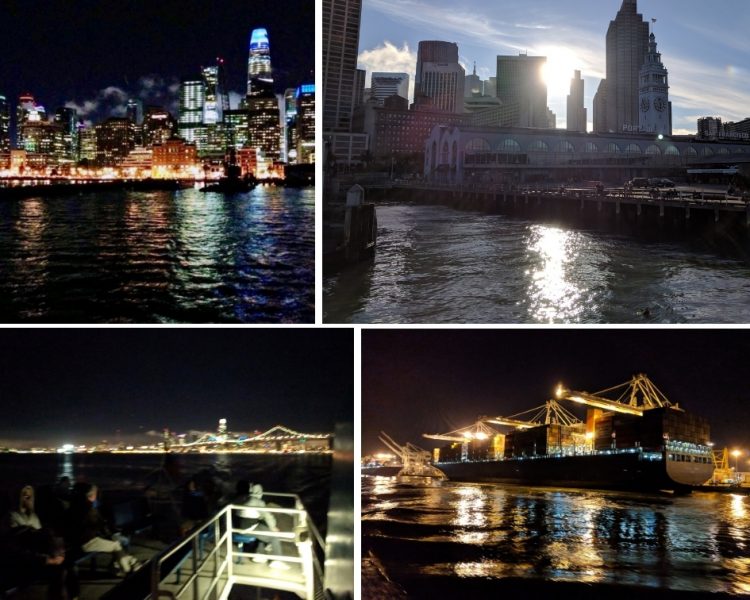
But while standing on the top deck of a ferry a few years ago, we were reminded of one of the “costs” of the ride. The smoke from the stacks occasionally wafted and stalled over the boat as it turned and maneuvered.
During the public-debate phase of the Berkeley ferry terminal in 2009, one comment included an analysis of fuel efficiency of transit vehicles, which was compiled by Paul Kamen. Using BTU/passenger-miles, which is based on the chemical energy of the fuel burned for each vehicle, a single-occupancy car uses 7,000 BTU per passenger-mile (assuming the car gets 20 miles to the gallon), a carpool 2,300 (also assuming 20 mpg), a bus 660, light rail, 91, and the BART train 68. (Most of these modes of transportation use about double the BTUs per passenger-mile when they’re not fully loaded; fewer passengers equal less efficiency per mile.)
The Peralta — a 331-passenger, 25-knot service-speed WETA boat (which is “two generations older than our core vessels,” according to the spokesperson) — uses between 4,560 BTU/passenger-miles when half full, and 2,280 at capacity. “Fifty percent capacity is about the best you can expect for a commuter service, considering the reverse-commute direction, while a carpool can operate at near 100% both ways,” Kamen said.
“We’ve reformed our fleet over the last few years to meet California’s air-quality standards, which are the strictest emission standards in the country,” a WETA spokesperson told us. WETA’s Hydrus and Pyxis classes — which include seven 400-plus-passenger, 27- to 35-knot service-speed boats — are equipped with “Tier 4” engines. “[These vessels] were the first of their kind in the country; it’s the cleanest you can have for a diesel engine,” the spokesperson said of Tier 4, which is an emission standard established by the Environmental Protection Agency and the California Air Resources Board. (The Hydrus class, which debuted in 2017, technically has “Tier 3” engines with “additional pollution control systems,” to meet Tier 4 standards, the WETA spokesperson said.)
Despite increasing cleanliness, ferries are still thirsty animals; some estimates say they use up to 300 gallons of diesel per hour.
What About a Zero-Emmission Vessel?
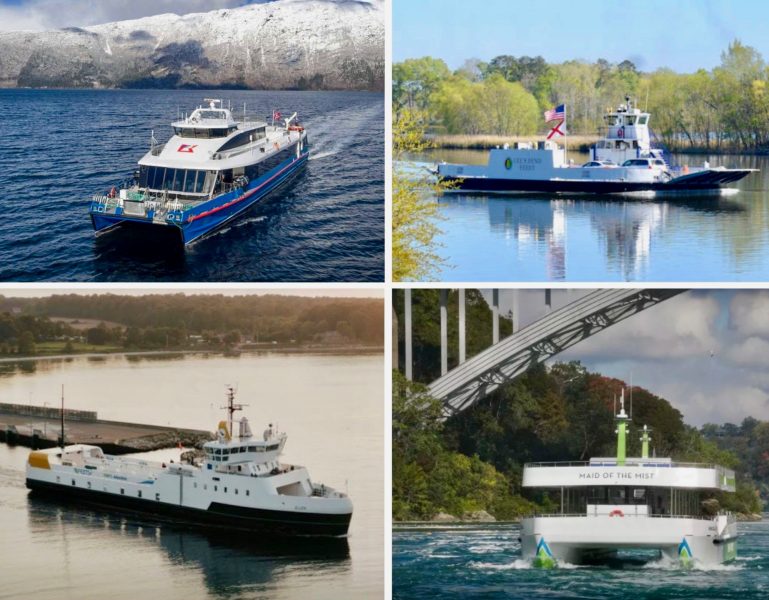
Earlier this year, WETA received a grant from the California State Transportation Agency to build their first battery-electric zero-emission ferry. “It would serve the future connector route to the Mission Bay neighborhood of San Francisco,” the spokesperson told us. “We are eager to begin that project and deliver a zero-emission passenger ferry that will move us and the maritime industry forward. It’s a huge learning opportunity. Building the required infrastructure, building a vessel, and putting it into service will teach us a lot, push the industry forward, and let us make smart decisions for the future of the fleet going forward.” The spokesperson added that WETA is seeking grants to fund the creation of a comprehensive green-fleet blueprint for the ferry system.
Are electric ferries a “magic bullet” for transportation? An electric-powered anything is, of course, only as clean as the energy that it plugs into. There are also skeptics of the hybrid concept’s being used in a maritime setting. “Hybrid power makes no sense for an application that requires steady, continuous power output,” Paul Kamen said. “The low-carbon output from demo projects is a consequence of lower speed, not hybrid power. Hybrid is great for cars because they require frequent power surges. But that’s not the case for boats and ships. It’s no accident that the venerable Atomic Four engine block was originally for a tractor motor.”
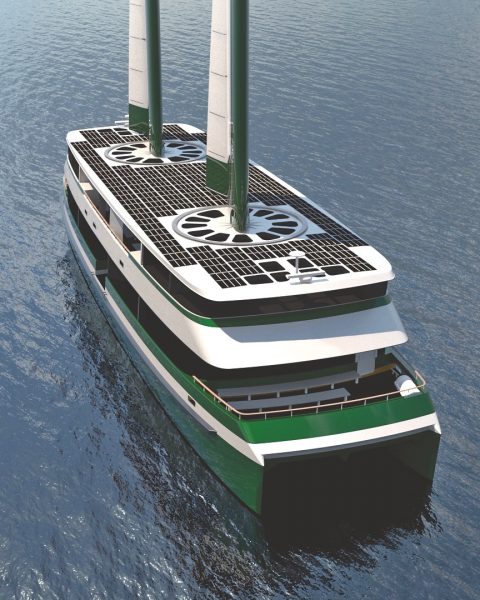
Back to the Berkeley Ferry Question
“Since WETA and the City of Berkeley are early in the planning phase of this project, all options for vessel propulsion technology will be considered,” the WETA spokesperson told us.
It’s not clear, however, how much say individual municipalities ultimately have in what type of vessels will service their line. Richmond mayor Tom Butt told us that his administration was strongly behind an electric ferry for the city’s WETA-run line, which opened in early 2019. But the line is currently serviced by a diesel ferry. “We had very little say; we weren’t part of the decision-making apparatus.” The WETA spokesperson told us that vessel considerations are made not just for individual lines, but for the needs of the entire fleet.
Exactly what types of boats may or may not service a Berkeley line — if there is to be a ferry there — remain up in the air. Discussion of the pros and cons of a Berkeley ferry line might hint at debates that will play out in other parts of the Bay Area. With Treasure Island, Mission Bay, Redwood City, Seaplane Lagoon in Alameda, and cities in the the South Bay and Carquinez Strait all considering new ferry lines, the discussion will revolve around each each municipality’s unique financial situation, waterfront geography and environmental-policy goals.

Having Ridden the ferrries in the late ’40s and early 50s, I loved them — Jack London and the Sea Wolf not withstanding. It would be a great tourist attraction as well as relieving current freeway congestion.
I see the City and / or developer is building a new pier on the west side of Treasure Island for ferries to run between the Island and SF Ferry Terminal. Any news on who will be in charge of that, and whether that will be a higher-tech boat than the rest of the SF fleet?
Tom — There is no word on the type of boats being considered for TI, but there has been strong lobbying for wind-assist and low-emission vessels on the route.
Hybrid system can effectively provide propulsion and electrical power generation. Check out the systems sold here: https://hybridmarine.co.uk/index.php/products/seagoing-hybrids. I’m sure there are others. The increasing energy density of batteries at ever lower prices means electricity’s maritime future is bright.
Surely a bus service to / from Treasure Island would be cheaper, faster and more frequent. The same buses could drive the loop around Treasure Island, making it very convenient for commuters. (Don’t get me wrong, I love ferries, but this is probably a mistake enabled by government subsidies.)
Tim — The story mentions how at least part of the ferry expansion is being funded by a bond measure passed by voters in 2018. (The measure raised bridge tolls around the Bay). Also quoting from the story: “It’s not uncommon for cities to partner with [public ferry-services] as a means of investing in their public transit,” similar to a city subsidizing/financing/paying for its bus service.
Buses are among the most efficient forms of transportation in terms of amount of fuel used per passenger mile, but they add to congestion. Imagine what the Bay Area’s traffic will look like in 2040, by which time 1.1 million cars are expected to have been added to the road. (And parking lots.)
It’s a question of tradeoffs, and tailoring transportation to specific regional needs. Ferries are certainly among the more expensive and inefficient options, but if there was a fleet of truly zero-emission vessels — worthy of the Bay Area’s reputation for cutting-edge innovation and maritime savvy — a mass-ferry system might start to look more attractive.
(Also, at some point, the subject of population sustainability will have to be a topic at city council meetings, national elections, and in the body politic at large.)
Over the water mass transit is not nearly as practical as land based systems. Land based buses have flexibility for peak and non peak hours by adding and deleting reasonably sized units. While watercraft can utilize basically free routes, they can be restricted by weather and also require expensive terminals. Those terminals also become choke points in peak times and would need additional parking, street upgrades and other ancillary services. To be even a modest success would require an enormous initial outlay and right now is not a good time. This is a project that needs to be shelved while resources are used elsewhere and possible alternatives considered. I am not convinced that this has been thought out well enough.
On the Question of which is the most efficient mode of transportation: while it may be true, (based upon an older generation 25 kts ferry) that the ferry out performs the single occupant car efficiency at 20 mpg. It is certainly not true of the newer and larger 32 kt. WETA vessels where the pmpg (passenger miles per gallon) is 13 pmpg for the entire WETA fleet, with the Vallejo route the most efficient at 17 pmpg and the least efficient route at 5 pmpg or lower. Also, the newer WETA vessels had to be lengthened about 8 feet to accommodate a couple of tons of emission filters, making the “cleaner” diesels burn even more fuel. Diesel Free by 2033? Great slogan but………
The average car efficiency now stands at 26 mpg for a single occupancy vehicle (combined city and hwy) not 20 mpg and if you have 2 people in it then it is 52 pmpg. If you have a Prius hybrid (55 mpg) you can get 110 pmpg with two passengers. And so on.
Ferries also have the problem of many commute lines where the vessel returns from a full run essentially empty, so the highest capacity utilization over both legs might achieve 50% capacity. Whereas a single car does not return empty, but with the same passenger load. That ferry is still burning 300 gallons per hour on that essentially empty return trip.
Now include all electric vehicles that can get 110 mpge (e = electric equivalent) with two passengers and you are up to 220 pmpg, this is far better than any diesel powered ferry could ever achieve and approaching the efficiency of the BART system of 270 pmpg.
We have run into public transportation gurus that do not like to admit that the single passenger car is more efficient than MOST of the public transportation systems. In Napa where I live, the VINE aka Napa Transportation System runs with 40 to 50 passenger buses with one or two people on board, and one of those is the driver! Essentially it is a single passenger vehicle that gets 6 mpg, with two onboard that is 12 pmpg, worse than the ferries. And NO ONE aspires to take the bus, they would rather bike or take Uber, Napa is an ideal town for bikes. Transportation Gurus are trying to build a Big City, SF style transportation system in a Rural County, and as always they are fighting the LAST war. That system costs 16 million per year to run and untold thousand of tons of GHG. It is sheer madness, but nobody will tell the Emperor…………. An all electric Uber type/ on demand type service could take 10 times more passengers directly to their destinations, when they want to go, no waiting at bus stops, and for half the cost of the empty buses and with 30 times less GHG emitted. And it solves the “Last Mile Conundrum” getting the transit user from the bus stop to their destination because they are already at their destination.
At least people LOVE the ferry! Nobody likes to wait for a bus.
A detailed wind study showed that the all electric ferry to Alcatraz was going to get 75% of it’s motive power from the wind, the rest would have been electric, it would have blown BART out of the water for efficiency. But just like I do not want politicians designing the Health Care System, (leave that to the experts like Kaiser Permanente, THEY know health care) we need some new thinking for the Ferry System. Otherwise WETA will have some serious White Elephants to sell off before 2033.
Thanks Tim for the article!
Great article Tim.
For what it is worth, the Red and White fleet already has a hybrid ferry. It would be good to find efficiency numbers like Jay Gardner posted.
Secondly, either Blue and Gold or Red and White have a “wind assisted” ferry. It sports two vertical axis wind turbines mounted on the top. I’m sure they can’t create much energy, but at least she is running in the SF Bay and may offer some data.
Thirdly, Norway has been operating a large battery powered ferry since 2015.
“The electric ferry named Ampere entered into service in early 2015. It crosses the Sognefjord about 34 times a day (17 round trips) and has a capacity of 360 passengers and 120 cars. The 6 km crossing takes 20 minutes. The 1,000 kWh Li-ion battery system of the ferry is charged at each quay for about 10 minutes.The electric ferry named Ampere entered into service in early 2015. It crosses the Sognefjord about 34 times a day (17 round trips) and has a capacity of 360 passengers and 120 cars. The six km crossing takes 20 minutes. The 1,000 kWh Li-ion battery system of the ferry is charged at each quay for about 10 minutes. The electric ferry named Ampere entered into service in early 2015. It crosses the Sognefjord about 34 times a day (17 round trips) and has a capacity of 360 passengers and 120 cars. The 6 km crossing takes 20 minutes. The 1,000 kWh Li-ion battery system of the ferry is charged at each quay for about 10 minutes.”
Lastly, it would seem that the proposed run from Treasure Island for sure, and likely Richmond, and Berkeley, would be ideal for battery powered ferry boats.
Armand — Thanks for this. Good points all around.
We didn’t have the space to mention the Enhydra, the Red and White Fleet’s 600-passenger, 128-ft lithium-Ion battery plug-in; it’s “the largest plug-in hybrid electric passenger vessel built from the keel up under US Coast Guard regulations,” according to Red and White. (We took a spin on Enhydra in 2019, when the Sail GP fleet was in town and doing a few practice races.)
Because it’s a site-seeing boat, Enhydra cruises the Central Bay “in all electric-mode at seven knots for two-plus hours, consuming less than eight gallons [of diesel] per hour,” according to Red and White. It doesn’t have to do the speeds and distances that commuter ferries must do, in other words, and is really a different class of vessel — and different type of ferry service altogether. (The four-vessel Red and White fleet aims to be emission free by 2025.)
Thanks for mentioning the ferry’s with wind turbines. (I think a few vessels on the Angel Island run have them, as well.) I would also guess that they’re not providing tons of energy, but at least it’s something that can, hopefully, be built upon.
Really good point about the Norwegian ferry. A question that I now realize I failed to ask is, “Why do local public-ferry services have to develop an entirely new electric-hybrid vessel (seemingly from scratch), rather than purchase boats and technology already proven in other countries?” I have been told by spokespeople that local ferries need to by “system specific,” meaning that they’re built for Bay Area-conditions, and can service any route within the Bay. But my guess is that if a vessel is good enough for use in Norway, it’s good enough for here!
What’s more, why isn’t the Bay Area — a technology and maritime hub — leading the way to create zero-emission vessels?
To your last point, we agree. We hope that, during the public-engagement process on the many new proposed ferry lines throughout the Bay, there will be strong advocacy for electric or wind-assist vessels.
Hi all! I’m with the UC Berkeley Graduate School of Journalism covering the potential for expanded ferry service in the Berkeley Marina. All you folks have lots of interesting things to say regarding this, and I would love to hear from you regarding how you feel about a ferry terminal in Berkeley, how feasible it is, how popular it would be, etc. Please reach out if you’re interested in chatting with me about it!